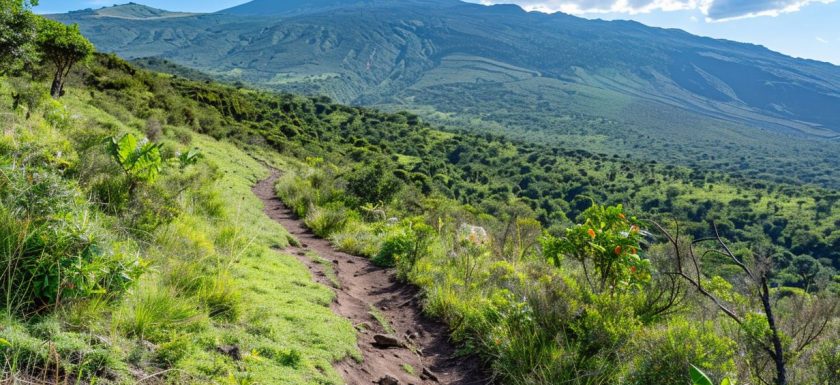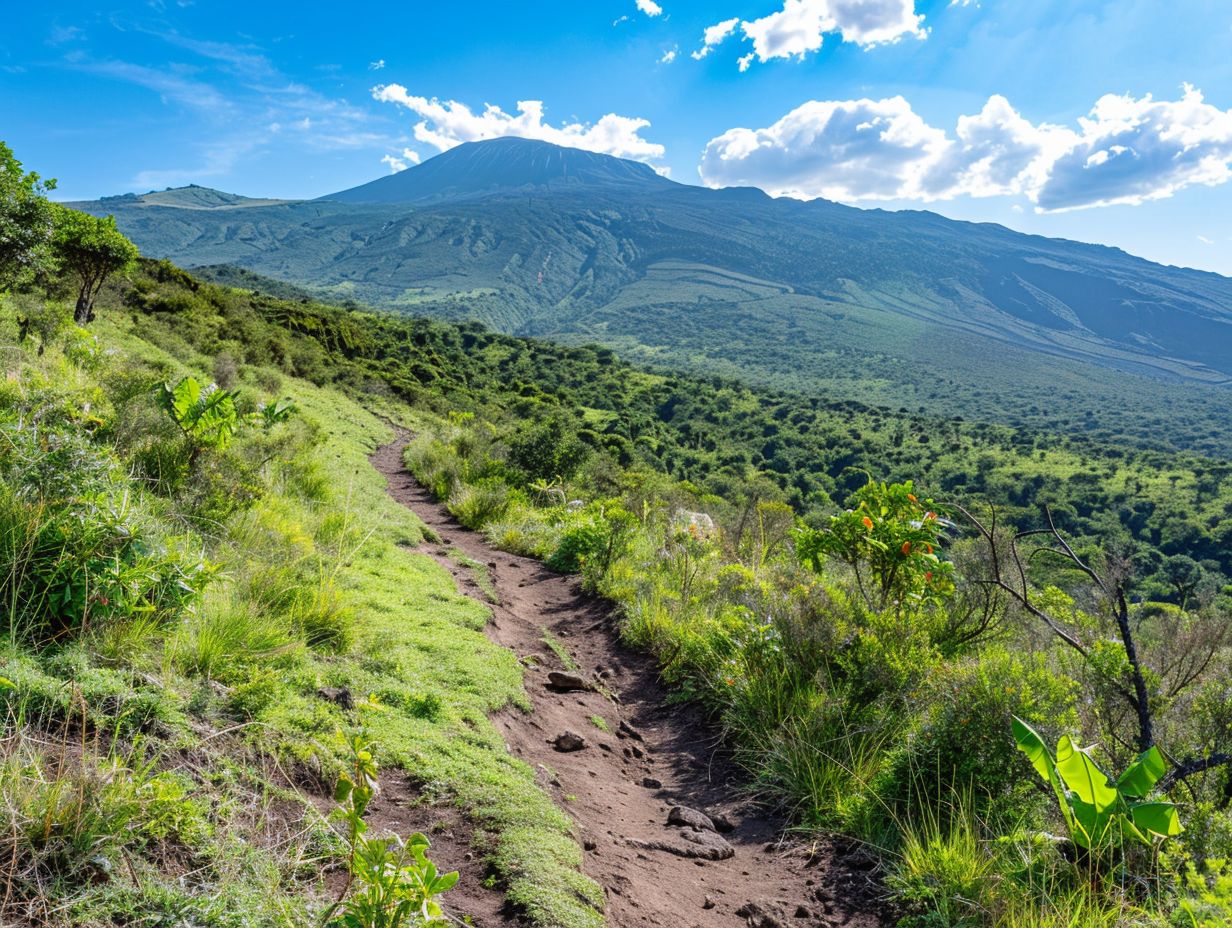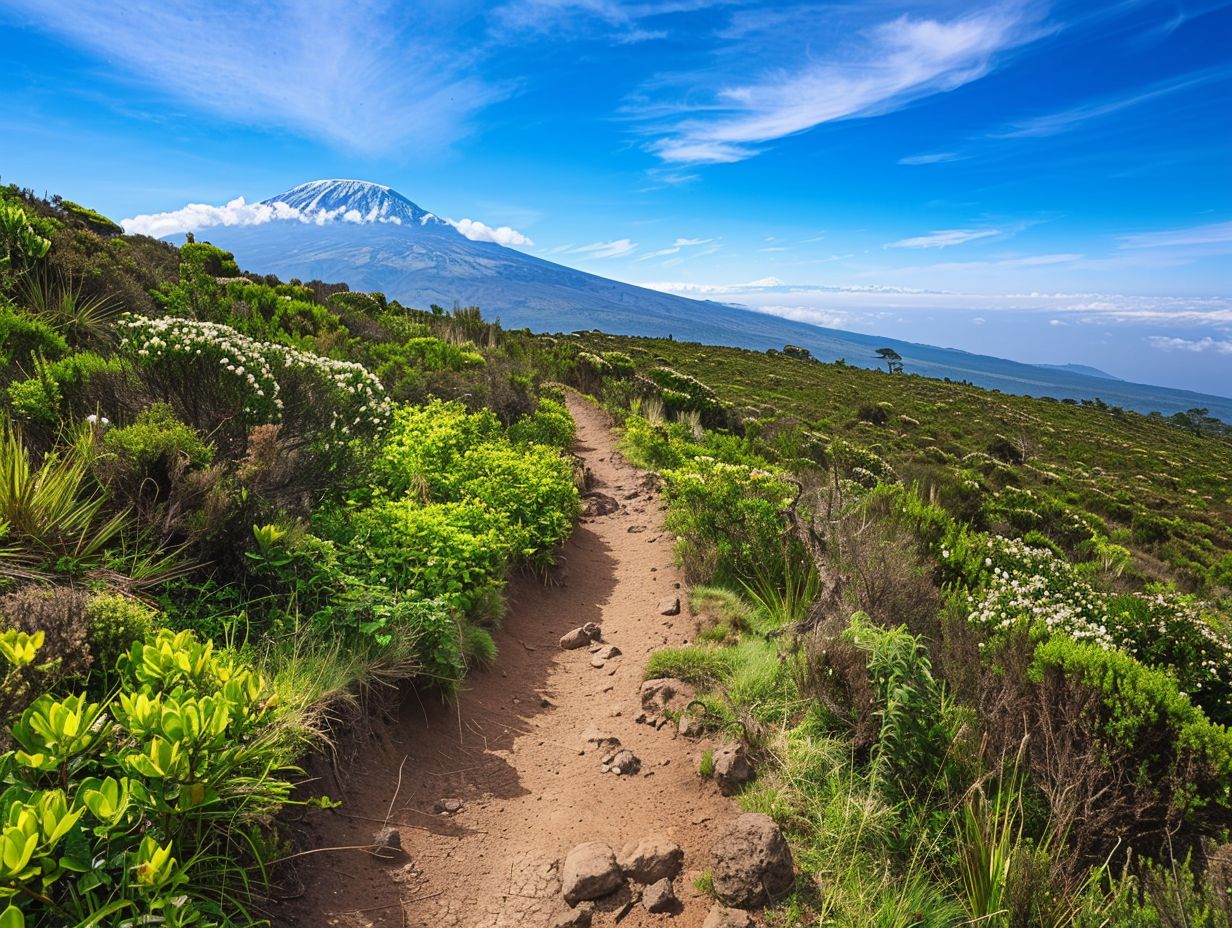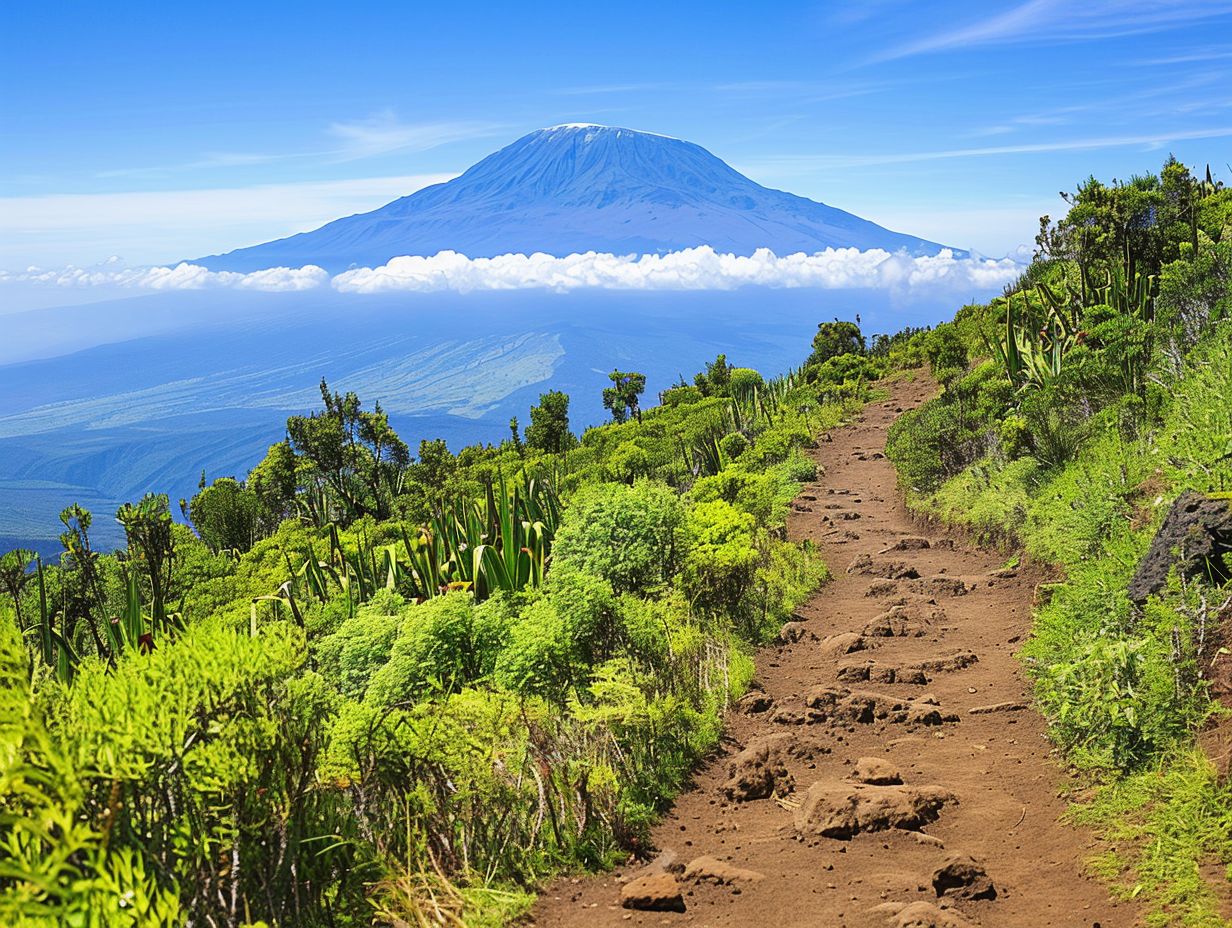
Are you planning to conquer Mount Kilimanjaro but unsure of which route to take?
Explore the easiest Kilimanjaro routes, including the Marangu, Rongai, Machame, Lemosho, and Northern Circuit routes.
Discuss the pros and cons of each route, consider factors such as difficulty level, scenery, and crowds, and help you make an informed decision for your Kilimanjaro adventure.
Lace up your boots and get ready for an epic journey to the Roof of Africa!
Key Takeaways:

- The Marangu Route is the easiest Kilimanjaro route, but it’s also the most crowded and lacks scenic views.
- The Rongai Route offers a more secluded and diverse landscape, making it a great option for those seeking a less crowded but still relatively easy route up Kilimanjaro.
- The Lemosho and Northern Circuit routes are more challenging than the Marangu and Rongai routes, but they offer breathtaking scenery and a unique experience of the mountain.
What is the Easiest Kilimanjaro Route?
Determining the easiest Kilimanjaro route involves considering factors such as the level of difficulty, scenic views along the way, and the success rate of trekkers reaching the summit.
The difficulty level of a route on Kilimanjaro can vary significantly, with some paths presenting more challenging terrain and requiring higher levels of fitness and experience.
The scenic beauty of the route is another crucial aspect to consider, as climbers are rewarded with breathtaking views of the Tanzanian landscape and wildlife along the way.
Route length plays a key role in determining the ease of a Kilimanjaro climb, with longer routes typically allowing for a more gradual ascent and better acclimatization.
The success rate of climbers reaching the summit is a testament to the route’s accessibility and suitability for trekkers of different skill levels.
Factors to Consider When Choosing a Route
When selecting a Kilimanjaro route, important factors to consider include the level of trekking experience, the need for proper acclimatization, the terrain’s difficulty and elevation gain, availability of camps and huts for accommodation, and recommendations to prevent altitude sickness.
For trekking experience, routes vary in terms of difficulty levels and duration, with some being suitable for beginners while others demand prior high-altitude trekking experience. Proper acclimatization involves gradual altitude gain to allow the body to adjust to lower oxygen levels, reducing the risk of altitude sickness.
The terrain can range from rocky paths to snow-covered trails, impacting the physical challenges and necessary equipment. Different camps and huts along the routes offer various amenities and comfort levels, influencing your overall trekking experience and rest quality.
To prevent altitude sickness, staying hydrated, eating well, and pacing oneself are essential. Proper rest and medication can aid in acclimatization and reduce the risk of altitude-related issues.
Overview of the Marangu Route
The Marangu route, often referred to as the ‘Coca-Cola‘ route, is recognized for its hut accommodation, making it one of the more popular choices for climbers seeking a comfortable ascent towards the summit.
One of the unique aspects of the Marangu route is the availability of well-equipped huts along the trail, offering shelter and basic amenities to climbers. These huts provide a more comfortable experience compared to camping, adding a touch of convenience to the journey.
The success rates on the Marangu route are relatively higher due to a gradual climb profile, allowing climbers to acclimatize better and increasing their chances of reaching the summit. The route’s approach to Uhuru Peak, the highest point on Mount Kilimanjaro, entails a breathtaking trek through various ecological zones, offering a diverse landscape experience.
Pros and Cons of the Marangu Route
Exploring the advantages and disadvantages of the Marangu route can help climbers make an informed decision about whether this route aligns with their preferences and expectations.
One of the main advantages of the Marangu route is the availability of hut accommodations, providing a more comfortable sleeping environment than camping in tents. This feature can be particularly appealing for climbers who prefer a bit more comfort during their trek.
The Marangu route is often considered to have a higher success rate in reaching the summit due to a more gradual ascent, allowing for better acclimatization. This gradual ascent can also be a disadvantage as it may not be as beneficial for proper acclimatization, potentially increasing the risk of altitude sickness.
Climbers also mention that the scenic views along this route are not as diverse or panoramic as other routes, which could be considered a drawback for those seeking a more picturesque experience. Despite its cons, the Marangu route remains popular for its relative ease of access and the historical significance attached to it, making it a well-rounded choice for climbers of varying experience levels.
Overview of the Rongai Route
The Rongai route on Kilimanjaro offers climbers a unique experience, characterized by its wilderness approach from the Northern slope of the mountain.
Unlike the more crowded routes like Marangu and Machame, Rongai provides a sense of solitude and serenity, ideal for those who value tranquility amidst nature.
The route’s gradual ascent on the drier side of the mountain offers stunning vistas of the Kenyan plains below, adding a different dimension to the trekking experience.
While not as steep as some other routes, Rongai still presents challenges like the notorious ‘Breakfast Wall,’ a steep scramble that tests climbers’ agility.
Rongai’s allure lies in its less-trodden path, unique landscapes, and the opportunity to witness Kilimanjaro’s beauty from a distinct perspective.
Pros and Cons of the Rongai Route

Analyzing the benefits and drawbacks of the Rongai route can assist climbers in evaluating whether this route aligns with their preferences and trekking goals.
One of the key advantages of the Rongai route is the wilderness experience it offers. The route is known for being less crowded compared to some other popular paths, allowing climbers to truly connect with nature and immerse themselves in the peaceful surroundings. The Northern slope approach on the Rongai route provides a unique perspective of Kilimanjaro, offering breathtaking views that are different from the more common Southern approach.
While the route may lack some of the scenic variety found on other paths, the camping options along Rongai can be a plus for climbers looking for a more tranquil setting. There are designated campsites that provide a comfortable and safe environment for resting during the ascent.
Challenges such as less acclimatization time due to the rapid ascent and the potential for encountering colder weather conditions on this side of the mountain are aspects to consider.
Despite these challenges, many climbers find themselves satisfied after completing the Rongai route, cherishing the unique experience and the sense of accomplishment that comes with conquering Kilimanjaro through this less-traveled path.
Overview of the Machame Route
The Machame route stands out for its breathtaking scenery along the Southern slope of Kilimanjaro, offering trekkers a visually stunning journey to the summit.
Known as the ‘Whiskey Route,’ Machame boasts diverse landscapes, from lush rainforests to moorlands, and the famous Barranco Wall that challenges climbers with its steep ascent.
Traveling through verdant vegetation, climbers are treated to panoramic views of glaciers as they ascend through the Shira Plateau, providing a sense of accomplishment amidst the rugged beauty.
The route’s campsite locations, such as Machame Camp, Shira Cave Camp, and Barafu Camp, offer strategic resting points for climbers to acclimatize, connect with fellow trekkers, and recharge for the next leg of the journey.
Pros and Cons of the Machame Route
Delving into the advantages and disadvantages of the Machame route can provide climbers with valuable insights to gauge whether this route fits their preferences and expectations.
The Machame route, known for its stunning scenic beauty, offers breathtaking views of the southern slope of Kilimanjaro, encompassing an array of diverse landscapes from lush rainforests to alpine deserts. Climbers are captivated by the ever-changing scenery along the way, making each day of the trek a unique experience.
While the Machame route provides a more gradual ascent compared to some other routes, the steep and challenging terrain can test climbers’ physical endurance and mental resilience. The camping facilities on this route are well-equipped, offering comfortable resting spots after a demanding day of trekking.
Overview of the Lemosho Route
The Lemosho route on Kilimanjaro offers climbers a scenic trek through the Western Breach, providing a unique perspective of the mountain’s beauty and challenges.
With its longer duration compared to other routes, the Lemosho trail allows for better acclimatization, increasing the chances of a successful summit bid. The route also stands out for its varied landscapes, from lush rainforests to alpine deserts, offering a truly immersive experience. Climbers can enjoy camping under the star-lit African skies at picturesque campsites along the way, enhancing the sense of adventure and connection with nature.
Pros and Cons of the Lemosho Route
Assessing the strengths and weaknesses of the Lemosho route can aid climbers in determining whether this route aligns with their preferences and aspirations for the Kilimanjaro ascent.
The Lemosho route is renowned for its breathtaking scenic vistas, offering trekkers unforgettable views of Kilimanjaro. This route also provides a unique chance to conquer the Western Breach, a challenging but exhilarating segment that adds an element of thrill to the climb. Climbers on the Lemosho route are treated to diverse terrain, ranging from lush rainforests to alpine deserts, making the journey truly captivating.
Overview of the Northern Circuit Route
The Northern Circuit route on Kilimanjaro offers climbers an extended trekking experience with a high success rate in summit passage, making it a popular choice for those seeking a comprehensive mountain adventure.
Spanning approximately 9-10 days, the Northern Circuit route is one of the longest routes on Mount Kilimanjaro, allowing trekkers to gradually acclimatize to the altitude. This extended duration not only enhances the chances of successful summit endeavors but also offers breathtaking views of diverse landscapes along the way.
The route is renowned for its scenic beauty, showcasing the varying ecosystems of Kilimanjaro, from lush rainforests to alpine deserts. Campsites on the Northern Circuit are well-equipped with essential amenities, providing trekkers with comfort amidst the challenging climb.
The longer duration of the trek allows for better acclimatization, reducing the risk of altitude-related illnesses and ensuring a safer and more enjoyable climb. This route appeals to seasoned trekkers looking for a challenging yet rewarding experience that encompasses the beauty and grandeur of Kilimanjaro.
Pros and Cons of the Northern Circuit Route

Exploring the advantages and disadvantages of the Northern Circuit route can assist climbers in determining whether this route suits their trekking preferences and objectives for conquering Kilimanjaro.
The Northern Circuit route presents several challenges, including its lengthy duration, typically spanning around 9 to 10 days, demanding physical endurance and mental resilience from trekkers.
While the route boasts a high success rate in reaching the summit due to the gradual altitude gain and extensive acclimatization periods, climbers need to be prepared for the unpredictable weather conditions that can vary drastically at different altitude levels.
One of the notable pros of this route lies in the breathtaking scenic viewpoints it offers, providing trekkers with panoramic vistas of the surrounding landscapes and diverse ecosystems.
Comparison of the Easiest Kilimanjaro Routes
When comparing the easiest Kilimanjaro routes, factors such as difficulty level, scenic beauty, traffic density, and crowd presence can influence climbers’ decisions on the ideal route for their ascent.
One of the most straightforward routes on Kilimanjaro is the Marangu Route, also known as the ‘Coca-Cola’ route. It offers manageable trekking, gentle slopes, and hut accommodations, making it a popular choice for novice climbers.
In contrast, the Rongai Route provides a quieter and less congested experience with diverse landscapes and wildlife sightings. The Machame Route, while slightly more challenging, boasts stunning scenery and higher success rates due to its gradual acclimatization profile.
Each route offers a unique blend of challenges and rewards, catering to different preferences and skill levels.
Difficulty Level
Assessing the difficulty levels across different Kilimanjaro routes is essential for climbers to gauge the physical and mental challenges they may encounter during the ascent, including elevation gains, varied terrains, acclimatization requirements, and risks of altitude sickness.
One of the most popular routes, the Marangu Route, is known for its gradual incline but lacks the opportunity for proper acclimatization due to its quick ascent.
Conversely, the Machame Route offers more diverse terrains, including challenging sections like the Barranco Wall, demanding higher fitness levels.
For those seeking a quieter, more scenic path, the Lemosho Route provides a longer, more gradual ascent, allowing for better acclimatization.
The Northern Circuit Route stands out for its low traffic, making it a great choice for altitude acclimatization, although the extended duration requires good physical endurance.
Scenery and Views
Exploring the scenic beauty and breathtaking views offered by different Kilimanjaro routes can greatly influence climbers’ preferences, providing them with a deeper appreciation for the diverse landscapes, wilderness encounters, camp settings, and hut accommodations along the way.
Each Kilimanjaro route boasts its own unique appeal.
- The Machame route, known for its stunning rainforest section, treats trekkers to lush greenery and diverse wildlife.
- On the Lemosho route, travelers are awe-struck by the vast Shira Plateau and its panoramic vistas.
- The Marangu route, often called the ‘Coca-Cola route,’ features cozy hut accommodations amidst striking scenery.
- Rongai route, on the other hand, offers a quieter, more remote trek, ideal for those craving solitude in nature.
These varied landscapes and experiences make Kilimanjaro a paradise for nature enthusiasts and photography aficionados.
Traffic and Crowds
Considering the traffic congestion and crowd density on different Kilimanjaro routes is crucial for climbers seeking a serene wilderness experience, as it impacts the trekking ambiance, campsite availability, acclimatization opportunities, and overall sense of solitude during the ascent.
Among the various routes up Kilimanjaro, the Marangu route is often deemed as the most crowded, due to its popularity and the presence of huts along the trail.
This can lead to a more social experience but may also reduce the feeling of wilderness immersion. In contrast, the Lemosho and Rongai routes typically offer a more secluded trekking atmosphere, allowing for a greater sense of solitude amidst the mountain’s grandeur.
For those prioritizing campsite occupancy, routes like Machame and Umbwe might be preferred, offering more space in overnight stops but potentially busier trails during the day. Acclimatization conditions can vary, with slower ascents on routes like the Northern Circuit providing better altitude adjustment opportunities.
Frequently Asked Questions
What is the Easiest Kilimanjaro Route?

The easiest Kilimanjaro route is known as the Marangu route, also called the “Coca-Cola” route due to its popularity and availability of amenities. It is the only route on Kilimanjaro with huts for accommodation rather than tents, making it a good option for beginners.
How long does it take to complete the Easiest Kilimanjaro Route?
The Marangu route typically takes 5-6 days to complete, with an optional extra day for acclimatization. This makes it the shortest route on Kilimanjaro, and the most popular choice for those with limited time.
What is the success rate for the Easiest Kilimanjaro Route?
The success rate for the Marangu route is lower than other routes, at around 65%. This is due to the shorter duration of the trek and the lack of opportunity for proper acclimatization. However, with proper preparation and training, the success rate can be increased.
What is the terrain like on the Easiest Kilimanjaro Route?
The terrain on the Marangu route is well-maintained and less steep than other routes, making it easier to navigate. However, the final ascent to the summit is still challenging and requires a good level of fitness.
What is the best time of year to hike the Easiest Kilimanjaro Route?
The best time to hike the Marangu route is during the dry season, from June to October. This is when the weather is most stable and there is less chance of encountering rain and other adverse conditions.
Are there any age restrictions for the Easiest Kilimanjaro Route?
There are no official age restrictions for the Marangu route, but it is recommended for those over the age of 10 due to the physical demands of the trek. It is important to consult with a doctor before attempting any trek, regardless of age.